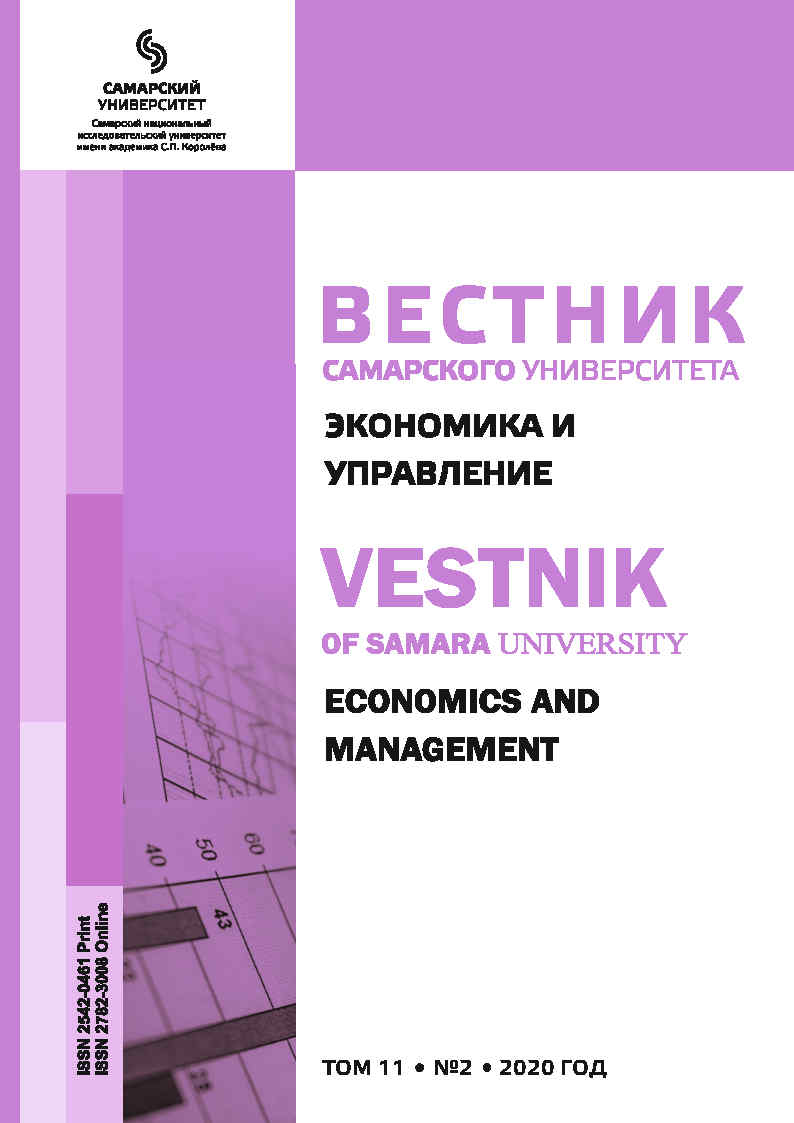MULTI-DIMENSIONAL WEIGHT CLUSTERING METHODOLOGY
- Authors: Trusova A.Y.1
-
Affiliations:
- Samara National Research University
- Issue: Vol 11, No 2 (2020)
- Pages: 166-178
- Section: MATHEMATICAL AND INSTRUMENTAL METHODS OF ECONOMICS
- URL: https://journals.ssau.ru/eco/article/view/7862
- DOI: https://doi.org/10.18287/2542-0461-2020-11-2-166-178
- ID: 7862
Cite item
Full Text
Abstract
The combined approach to the analysis of the socio-economic sphere is based on the use of information-mathematical methods. This allows you to expand the possibilities of a monothetic approach, for example, when structuring objects of research or indicators describing the studied objects. This approach is currently part of business intelligence. A multidimensional approach is applied in the classification of multidimensional data. Classical classification methods are complemented by the introduction of latent factors. The classification procedure based on latent factors without weight factors is described. In addition to expert methods, a methodology for estimating weight coefficients in multidimensional clustering is proposed. Given the structure of latent integrated indicators, the methodology of formation of weighting factors is considered.
The paper proposes structuring using non-metric multidimensional scaling techniques, including taking into account weighting factors. Given the ranking positions of clustering objects, a grouping is carried out in the theoretical space of stimuli. The share ratio of indicators both in latent factors and in the theoretical scale space allows us to exclude the use of expert estimates and their subjectivity. The paper also notes the possibility of combining and dynamic analysis in the analysis of multidimensional data arrays. As an object of study, indicators of the non-production sphere of the Volga Federal District are considered.
About the authors
Alla Yu. Trusova
Samara National Research University
Author for correspondence.
Email: a_yu_ssu@mail.ru
ORCID iD: 0000-0001-7679-9902
Candidate of Physical and Mathematical Sciences, associate professor, associate professor of the Department of Mathematics and Business Informatics
Russian FederationReferences
- Odintsova E.S. Growth dynamics of the Russian Federation territories: assessment of convergence trends. Rossiyskoe predprinimatelstvo = Russian Journal of Entrepreneurship, 2008, vol. 9, no. 5, pp. 10–15. Available at: https://cyberleninka.ru/article/n/dinamika-razvitiya-regionov-rf-otsenka-tendentsiy-konvergentsii. (In Russ.)
- Tatarkin A.I. Regional targeting of the economic policy of the Russian Federation as an institution of regional spatial development. Economy of the region, 2016, vol. 12, issue 1, pp. 9–27. Available at: https://cyberleninka.ru/article/n/regionalnaya-napravlennost-ekonomicheskoy-politiki-rossiyskoy-federatsii-kak-instituta-prostranstvennogo-obustroystva-territoriy. (In Russ.)
- Rastvortseva S.N. The main directions of the influence of external economic factors on the regions' development. Rossiyskoe predprinimatelstvo = Russian Journal of Entrepreneurship, 2015, vol. 16, no. 23,
- pp. 4193–DOI: https://doi.org/10.18334/rp.16.23.2170. (In Russ.)
- Makarova E.S. Classification of indicators of innovative potential of the region. Economics and innovations management, 2014, no. 2, pp. 25–29. (In Russ.)
- Markovskaya E.A. Effective economic management – a necessary condition for successful socio-economic development of the region. Rossiyskoe predprinimatelstvo = Russian Journal of Entrepreneurship, 2008, vol. 9, no. 10, pp. 63–68. Available at: https://creativeconomy.ru/lib/2828. (In Russ.)
- Nazarenko V.S. Analysis of trends in complex social and economical development of the cities of Lipetsk region. Journal of Economics, Entrepreneurship and Law, 2018, vol. 8, no. 1, pp. 51–63. DOI: https://doi.org/10.18334/epp.8.1.38729. (In Russ.)
- Kireyeva A.A., Mussabalina D.S., Tolysbaev B.S. Assessment and Identification of the Possibility for Creating IT Clusters in Kazakhstan Regions. Ekonomika regiona = Economy of Region, 2018, no. 14 (2), pp. 463–473. DOI: https://doi.org/10.17059/2018-2-10.
- Petina P.V. Evaluation of effectiveness of the implementation of the strategy of socio-economic development of the Samara Region. In: Industrial policy: globalization, innovation, sustainability: collection of materials of the all-Russian research and practical conference: N.M. Tyukavkin (Ed.). Samara: ANO «Izdatel'stvo SNTs», 2018, pp. 300–303. Available at: http://repo.ssau.ru/bitstream/PROMYShLENNAYa-POLITIKA-GLOBALIZACIYa-INNOVACII-USTOIChIVOST/OCENKA-EFFEKTIVNOSTI-REALIZACII-STRATEGII-SOCIALNOEKONO
- MIChESKOGO-RAZVITIYa-SAMARSKOI-OBLASTI-72143/(In Russ.)
- Ilyina A. I., Trusova A.Yu., Lyukshin D.E. Privolzhsky Federal District and its socio-economic indicators in the focus of multidimensional scaling. In: Industrial policy: globalization, innovations, sustainability: proceedings of the all-Russian research and practical conference. N.M. Tyukavkin (Ed.). Samara: ANO «Izdatel'stvo SNTs», 2018, pp. 68–73. Available at: http://repo.ssau.ru/bitstream/PROMYShLENNAYa-POLITIKA-GLOBALIZACIYa-INNOVACII-USTOIChIVOST/PRIVOLZhSKII-FEDERALNYI-OKRUG-I-EGO-SOCIALNO-EKONOMIChESKIE-POKAZATELI-V-FOKUSE-MNOGOMERNOGO-ShKALIROVA
- NIYa-72065/(In Russ.)
- Dubrov A.M., Mkhitaryan V.S., Troshin L.I. Multivariate statistical methods. Moscow: Finansy i statistika, 2003, 122 p. (In Russ.)
- Aivazyan S.A., Yenukov I.S., Meshalkin L.D. Applied statistics. Bases of modeling and initial data processing. Reference edition. Moscow: Finance and statistics, 2013, 472 p. Available at: http://bookre.org/reader?file=448628&pg=1. (In Russ.)
- Federal State Statistics Service. Available at: http://www.gks.ru (accessed 20.01.2020) (In Russ.)
Supplementary files









